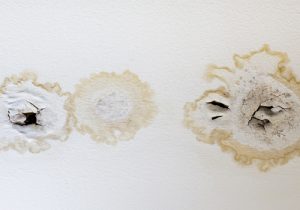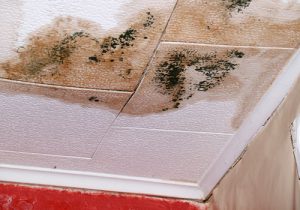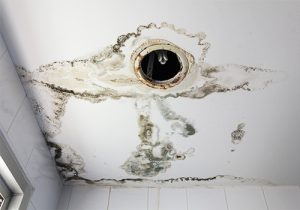Stains on ceilings are definitely one of the things that are worth further investigation, especially when you’re attending an open home for inspection.
Most of the time they’re indicators of past leaks which occurred a long time ago. But it still pays to be thorough. Failing to detect potential problems could mean stepping into a costly nightmare when you can least afford it.
Wet stains
A wet stain on a ceiling means an active leak and the first concern is roof damage. The damage caused will depend on how long the leak has been active. In this case enlist the help of a roof inspector to trace the source and test it with the help of a moisture meter. They will probably recommend immediate repair at a minimum (but a roof restoration is better) as active leaks can quickly destroy ceilings.
Dry stains
Dry stains indicate the leak that is causing the staining is not active. But it’s a good idea to find out from the seller what caused the stain and if it has been permanently corrected.
Here are some further types of stains that you should look out for as part of your inspection:
1. Stains under bathroom exhaust fans
This one is caused by condensation and is a common ceiling stain. It’s caused by an un-insulated duct that doesn’t have an airtight connection to a roof cap. Moisture that is meant to be expelled outside condenses and runs back along the duct to collect in the ceiling. Making the connection airtight will fix the problem.
2. Stains at outside wall/ceiling corners
Seeing stains in the corners or where the ceiling meets the wall could be from insufficient insulation in the attic causing a build-up of condensation or a roof leak. If the stain is brown it could be from the leak (tannins in the wood) but it could also be from possum pee.
3. Random ceiling stains
Random ceiling stains don’t necessarily mean water leaks. Again condensation is a common cause of random ceiling stains. If this is the problem then the nail heads in the roof could be rusty. This can be fixed by proper insulation and installing a ducted air conditioning system to reduce indoor humidity.
4. Stains below plumbing fixtures
These are easier to detect and fix than random ceiling stains but suggest that the plumbing is either faulty or has been at some point. A home inspector can test for active leaking if the stain is wet and will need to thoroughly test the plumbing fixture if the stain is dry.
Love the house but need a roof assessment for peace of mind? Reno Saver’s qualified builders can assist with a 31 point inspection. Get a free quote today!



